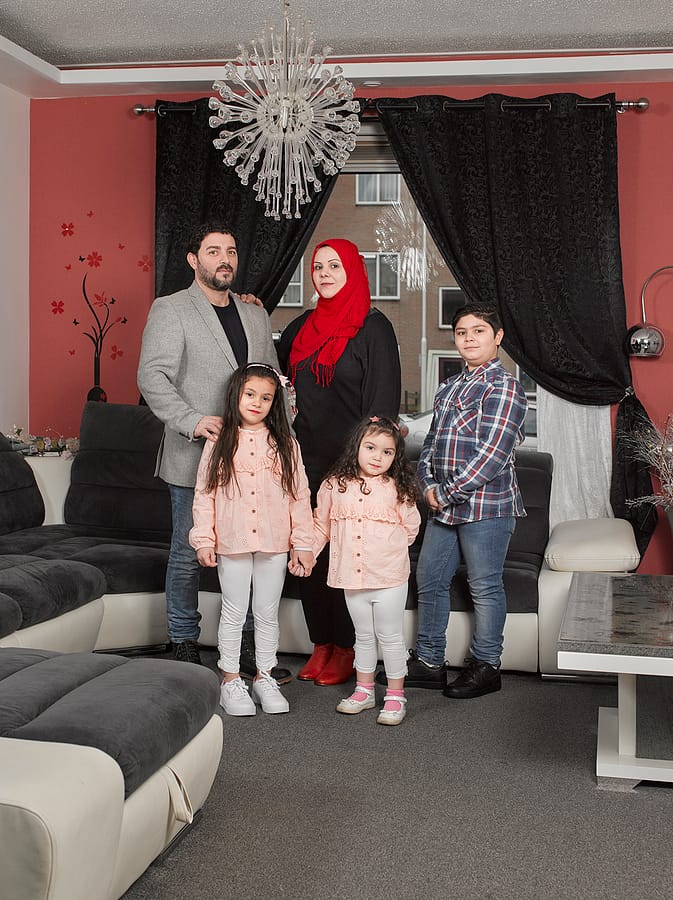
Living room Portrait Nr. 158 2020 // ©Bram Tackenberg
Photographer
Bram Tackenberg
The Story behind the Portrait
In my work, I seek to tame a somewhat always present noise so that everything falls in place and complex images become calm. Within this, I take a direct approach where I aim to create powerful yet fragile portraits. This thought process is one I carry with me when I enter people’s lives to do The Living Room portraits. In this series which began in 2014, I portray people in their own homes, in their own space. By looking and portraying without judgment, I aim to capture everyone in an equal, dignified way with the series illustrating the differences and similarities between people in a beautiful yet understated way.
My projects in general are about where we live, not about where we come from. I very much believe that everyone counts and aim to show this viewpoint through the work. The style of portraiture I use creates a proud image of the inhabitants of the Netherlands. The residents open themselves and their homes up to me and they are at once, both proud and vulnerable. The series currently consists of more than 180 portraits and a sequel is planned for the future.
The image above is Livingroom Portrait Nr. 158 2020. The young boy on the right is Hamza, who is 10 years old and goes to school in Gouda. He came to the Netherlands from Syria in 2015 with his parents and sister Halla and their little sister Tala was born here. Hamza’s father Samer works with the Promen, an organisation that supports people in getting back into work, whilst his mother Rana works at the local supermarket. They have been living in this house for three years now and Hamza talked of how he very much likes the street where the family live and he often plays outside with friends in the neighbourhood.
Hamza is often called to translate during a conversation. His parents don’t speak Dutch well yet, so Hamza interprets, “because I speak a little Dutch,” he explains modestly. In his spare time, he takes swimming lessons and is proud to have completed initial certificates and is on the intermediate stage. Hamza also likes to play football: “If my father gets a call from the club, then I play football,” he explains in his serious manner.
The best thing about their house is the cars that drive by and Hamza’s eyes lit up as he talked of how he likes to watch them. His favourite car is a Lamborghini, and he excitedly recounted how one drove through the street once. “Not at all fast but just the same speed that all cars drive”, he reassured me. It was a white one and Hamza confides that he wants exactly the same colour one day.
When asked what he wants to be when he grows up, Hamza consults with his parents. Lightning fast, in their native language. “Doctor” is their official answer. After a brief silence, Hamza admits to his own preference: “But rather the Police”.
Being invited into people’s personal space and entering their lives is something that makes my work very joyful. At first, my focus is on making sure everyone is relaxed, therefore we drink coffee and chat for a short while. During this time, I also decide what setup will work best for the portrait. I see the actual taking of the pictures as an act of concentration and cooperation between myself and those I portray. I cannot make these portraits on my own and I’m always grateful for the trust those I photograph show by letting me into their living rooms and working together on making the portraits. Portraying people this way, from all kind of backgrounds, in different settings, shows differences in people. Nevertheless, for me, what comes across most of all is actually how much we have in common with one another
The residents open themselves and their homes up to me and they are at once, both proud and vulnerable.
Bio
Bram Tackenberg (1974) is a Dutch portrait and documentary photographer. His photographic practice focuses on the mundane and the every day, concentrating on often overlooked subject matter. He believes in the slow development of his projects, staying away from what is one-dimensional or mediagenic. He is particularly interested in the relationship of how people relate to their surroundings and the tensions within that.
Bram’s work has been widely published in Dutch newspapers and magazines and is in the collection of Dutch museums. Since 2018, he has concentrated on making work with and for people in communities and local neighbourhoods.
